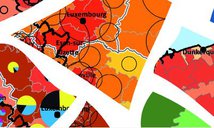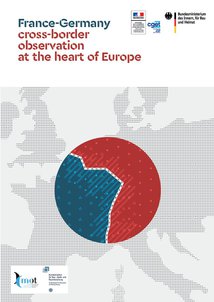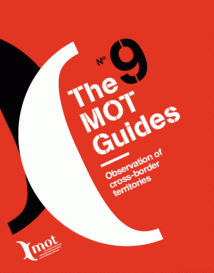Observation
Overview
Making the observation initiative permanent
The challenge today is to give overall coherence to and make permanent the individual cross-border observation initiatives being conducted in the cross-border areas. Often without the means to become permanent and not capitalised on politically by the competent authorities, these local initiatives are also under threat from local authorities’ budgetary restrictions and by the increasing thematic targeting of European programmes.
At national level
It was with this desire to make the observation initiative permanent and systematic that in the mid-2000s the CGET (formerly the DATAR) entrusted the MOT, and subsequently including the FNAU (the French network of urban planning agencies), with exploratory work aimed at establishing a cross-border component within the "Observatoire des territoires." This work concerned ten cross-border sites and seven different borders, and made it possible to:
- identify priority strategic themes that help to give a better understanding of the functioning of cross-border territories;
- establish a methodology for the collection of statistical information and to decide on sources (bodies in the countries and regions that produce these data);
- construct indicators and produce metadata records (definition and calculation of indicators, periodicity, scope covered, etc.);
- create a model for a database of geo-referenced data at different levels that can be regularly updated;
- design a common cartographic guide for town planning agencies that makes it possible to represent each territory at the same scale, with a common key for all of the cross-border territories analysed. The cartography is based on a predefined geographical breakdown which mainly corresponds to cantons in France, communes in Belgium, cantons in Luxembourg, Kommunen and Kreise in Germany, districts in Switzerland, ad hoc district groupings in Italy, and comunas and comarques in Spain. The result obtained corresponds to around 100 maps produced specially for this project by the different town planning agencies involved in the study;
- depending on the availability of the indicators selected for each of the ten territories studied, produce an overall analysis of the ten sites and a cross-sectoral analysis, indicator by indicator, in order to compare their functioning;
- lastly, produce a series of broad cross-sectoral analyses and conclusions that, by means of the indicators used, enable a better understanding of the very particular functioning of cross-border territories;
- based on the observations made, notably those about the technical obstacles relating to the comparability and availability of statistics, to put forward recommendations to improve networking between institutions that produce statistics in the border regions, to raise the awareness of France’s neighbours in order to secure their support in the coordination of statistical administrations and institutes; lastly, to raise the awareness of the European Commission on this crucial European issue of understanding better the functioning of these territories which serve as interfaces between European countries.
- Ultimately, the last output of this study made possible the introduction of a framework of minimum standards for the statistical observation of cross-border territories. This benchmark is available on the website of the CGET’s Observatoire des territoires. This preliminary study was followed by the work of UMS RIATE (Interdisciplinary Network for European Spatial Planning) resulting in the production in 2016 of a socioeconomic typology of the border regions in the European Union. This study brings innovative elements which help to better understand the dynamics of border areas at the regional level.
- The approach of the BBSR : In Germany, the BBSR (Bundesinstitut für Bau-Stadt- und Raumforschung), the Federal Institute for Research on Building, Urban Affairs and Spatial Development, has developed several observation initiatives on Germany’s borders. One such example is the MORO project (Demonstration Projects of Spatial Planning), whose goal is to determine how to include cross-border data in the federal observation system. The idea is to transform this project into a permanent observation system for the benefit of border regions.
At european level
The process is currently resulting in the involvement of countries at European level, with the challenge of including the observation of cross-border territories in the priorities of the EU’s 2014-2020 programming period (notably via financing tools such as ESPON, which have started to explore the issue: the Metroborder and Ulysses projects, etc.).
Indeed, European construction, which is being forged at the level of these “interface” territories, needs more than ever tools that enable detailed and ongoing knowledge of these regions. This observation initiative is a precursor to increased coherence on a larger scale (greater cross-border regions, macro-regions, etc.), even EU-wide, necessitating the cooperation of national governments and the Commission.
• The Cross-border Strategic Committee
It was in this context that a cross-border strategic committee (whose secretariat is provided by the MOT) was set up in 2013 in order to give impetus to a multi-annual work programme on cross-border observation. It is supported by a technical working group on cross-border statistical observation which is charged with analysing the themes proposed by the committee and with identifying and securing data sources and collection.
The technical working group brings together representatives of national and regional statistics offices, ministerial services or expert players with an interest in the initiative. Its role is to define and clarify the directives resulting from the work of the strategic committee, to set the conditions for the “technical realisation” and validate the work results before submitting them to the strategic committee.
• The Cross-Border Review
In 2015, on the occasion of the 25th anniversary of the Interreg programmes, the European Commission launched a public consultation on the theme of border obstacles: the Cross-Border Review. This saw the Directorate General for Regional and Urban Policy of the Commission (DG REGIO) qualitatively analysing the obstacles that remain on European borders and their consequences for the persons, organisations, businesses and public authorities in border regions. This qualitative observation forms part of a wider context of re-examination of cross-border cooperation that also includes a scientific study whose final results will be published in early 2017, and a series of workshops bringing together the stakeholders, notably representatives of cross-border cooperation associations, of the academic world, and business leaders.
The initial results of the consultation demonstrate that legal and administrative obstacles are those most frequently identified by the participants. Thus, the reappraisal of cross-border cooperation will now continue by concentrating on deeper analysis of a diverse array of legal and administrative obstacles. The public consultation has also revealed that linguistic obstacles and difficulties of access are frequently cited by participants. The latter confirms that the work on cross-border mobility is indispensable in border regions, and that the programmes, policies, and priorities need to be better adapted to the particular needs of these regions.
Meanwhile, the relatively rare mentions of lack of trust as an obstacle in border regions demonstrates that there is a good foundation upon which future cooperation efforts in border regions can be pursued. Precise recommendations concerning the measures to undertake to overcome the persisting obstacles will be proposed by DG REGIO in 2017.
The 2015 Luxembourg Presidency of the Council of the European Union greatly encouraged coordination between States on the topic of cross-border statistical observation, with an invitation made to the Commission and the Member States to work on a pragmatic, results-oriented approach, for European territorial cooperation programmes.
AT LOCAL LEVEL
At the local level, the crucial issue is the continuation of cross-border observation, with the support of European territorial cooperation programmes, and the ability of politicians and decision-makers to appropriate the work of the cross-border observatories to carry out their actions. To this end, the coordination between the technical and political levels must be optimal. This is the purpose of the launch of the intergovernmental initiative mentioned above.
Dunkirk-Western Flanders, Lille-Kortrik-Tournai, Luxembourg, the Lorraine Corridor, Strasbourg, Basel, Geneva, Nice, the Catalan Space, the Basque Country.




